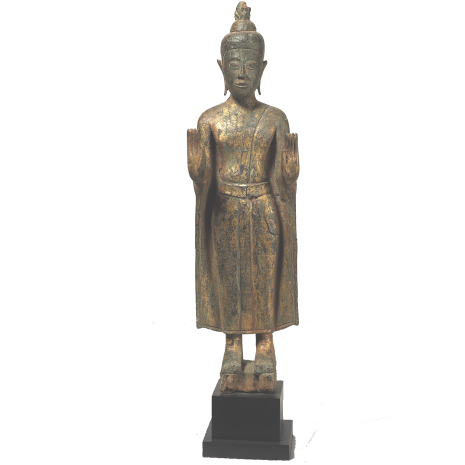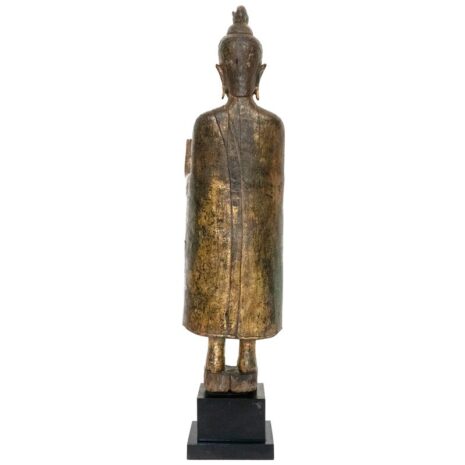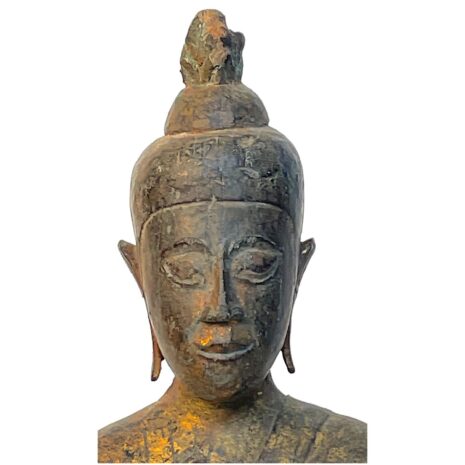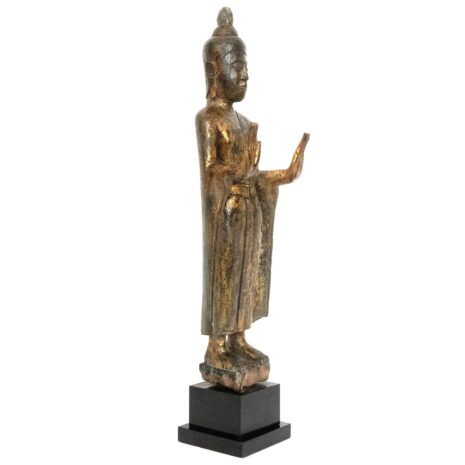Antique Carved Buddha in Freedom from Fear, Laos (3148LKE) $1275
$1,275.00
H: 20” W: 3.75” D: 3.75” | CALL 213-568-3030 FOR SHIPPING
This antique Lao Buddha stands in refined dignity displaying inner tranquility and strength, hands in abhaya mudra that connotes reassurance, divine protection, and dispelling fear and signifies Buddha’s spiritual power as he bestows protection from evil and ignorance and conveys “fear not” to devotees. As typical of Lao Buddhas he is covered in gilt visually reflecting his golden skin and a finial or radiance as a flame emerging from atop his head. His wet style Buddha robe that is smooth and graceful in its simplicity and adds elegance to the carving while showing his body underneath his clothing.
Description
This Lao Buddha reflects Theravada Buddhism, the original conservative tradition practiced in Southeast Asia depicting the Buddha, by closely following proscribed cannons in ancient texts. Lao sculptural styles resemble those of Northern and Northeastern Thailand where Buddha statues closely reflect the lakshana, the 32 “auspicious marks” or physical traits by which the Buddha can be recognized: golden skin, well-formed nose, hair with soft snail-crowned spiral curls and elongated body, face, long arms, fingers and hands. Unique to Lao Buddhas is the gilt covering to reflect his golden skin, curved-shaped pendulous ears and a distinctive flame-shaped radiance emerging from the ushnisha which functions as a spiritual aureole. He wears a thin wet style long uttarasanga (monastic robe) wrapped around his hips with a folded sanghati on his left shoulder. Laos and Thailand are unique in portraying Buddha holding up both hands in abhaya mudra with the arm crooked, palm of the raised hand facing outward, and fingers upright. Referred to as “Freedom from Fear” or the “Gesture of Protection,” it symbolizes benevolence, protection, peace and dispelling of fear representing Buddha’s fearlessness and spiritual power that he confers on others and also means “fear not” to all devotees viewing the image. It also is called the “Causing the Waters to Subside” or “Calming the Ocean” which reflecting Buddha’s visit to India where he met the monk Kasyapa who was giving sermons and living in a hut near a river that began to flood. The Buddha raised both arms and miraculously caused the floodwaters to recede resulting in Kasyapa and his followers converting to Buddhism. Lao artisans are said to be in both a spiritual and mental state when carving Buddhist statues enabling them to visualize the ideal Buddhist reality. This produces a wide variety of artistic styles with no images being identical. Although the Buddha is not perceived as a deity, Lao Buddhists often seek to communicate with the supernatural world through Buddha statues by praying and making offerings to them in temples and on home altars. Only part of the original high pedestal remains and has been replaced with a new two-tier stand but this Buddha otherwise is in very good condition with a dark patina showing its age.
Sources
Somkiart Lopetcharat, Lao Buddha, The Image and Its History, Bangkok, Siam International Book Company, Ltd, Thailand, 2000.
K.I. Matics, Gestures of the Buddha, Bangkok, Chulalongkorn University Press, 2001.
Additional information
| Place of Origin | Laos |
|---|---|
| Period | Antique (1200-1920) |
| Date | 18-19th Century |
| Materials and Technique | Wood |
| Dimensions (inches) | Ht: 20” W: 3.75” D: 3.75” |
| Dimensions (metric) | Ht: 50.80cm W: 9.52cm D: 9.52cm |
| Condition | Very good, see description |
| Item Number | 3148 LKE |
| Weight | 3lbs 7oz |
| Width | 0” to 5.9” |
| Shipping Box Size | Oversized. Call 213-568-3030 or email [email protected] for shipping. |










